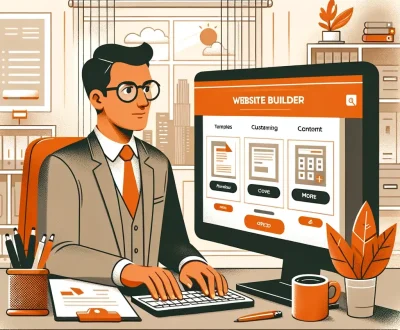Custom ecommerce website development is the process of creating an ecommerce website that is tailored to the specific needs of a business. It involves designing, developing, and optimizing an online store to provide a unique shopping experience to customers. Custom ecommerce website development is an essential aspect of online business as it helps to establish a brand identity, increase customer loyalty, and boost sales.

Understanding ecommerce website development is crucial for businesses that want to create a custom online store. The process involves several steps, including planning, design, development, and optimization.
Planning is the first step and involves defining the goals and objectives of the website. Design involves creating a visual representation of the website, while development involves coding the website and integrating it with various ecommerce platforms. Optimization involves improving the website’s performance, user experience, and search engine rankings.
Key Takeaways:
- Custom ecommerce website development is the process of creating a unique online store that meets the specific needs of a business.
- Understanding ecommerce website development involves several steps, including planning, design, development, and optimization.
- Custom ecommerce website development can help businesses establish a brand identity, increase customer loyalty, and boost sales.
Understanding Ecommerce Website Development
When it comes to ecommerce website development, there are several key factors that businesses should consider. From design to platform choice, each element plays a crucial role in creating a successful online store.
The Importance of Design in Ecommerce
Design is a critical aspect of ecommerce website development. A well-designed website can help businesses attract and retain customers, while a poorly designed website can drive them away. A clean, user-friendly design can increase the chances of visitors making a purchase and returning to the site in the future. It is important to ensure that the website is easy to navigate, with clear calls to action and a seamless checkout process.
Customization is also an essential part of ecommerce website design. By customizing the website to fit the brand’s identity, businesses can create a unique and memorable shopping experience for their customers. This can help build brand loyalty and increase customer engagement.
Choosing the Right Ecommerce Platform
Choosing the right ecommerce platform is another critical aspect of ecommerce website development. The platform should be easy to use, reliable, and scalable to accommodate growth. It should also include features that are essential for ecommerce, such as inventory management, payment processing, and shipping integration.
Customization is also important when it comes to ecommerce platforms. Businesses should choose a platform that allows for customization and flexibility, so they can tailor the website to their specific needs. This can include customizing the design, adding new features, and integrating with other tools and services.
Overall, ecommerce website development is a complex process that requires careful consideration of many factors. By focusing on design and platform choice, businesses can create a successful online store that attracts and retains customers.
Planning Your Custom Ecommerce Website
When embarking on the development of a custom ecommerce website, it is crucial to begin with a comprehensive plan. This lays the foundation for a successful and effective online platform.
Identifying Your Target Audience
Understanding the target audience is paramount in crafting a custom ecommerce website. By conducting thorough market research, businesses can identify the demographics, preferences, and behaviors of their potential customers. This knowledge allows for the creation of a website that resonates with the intended audience, leading to higher engagement and conversions.
Structuring Your Ecommerce Website
The structure of an ecommerce website plays a pivotal role in its functionality and user experience. A well-organized layout and intuitive navigation enhance the overall user journey, making it easier for visitors to find products and make purchases. Additionally, the website’s structure should align with the industry standards and best practices, ensuring a seamless and professional online presence.
By incorporating these considerations into the planning phase, businesses can set the stage for a custom ecommerce website that not only reflects their branding but also effectively caters to their target audience.
Development and Customization
Creating a custom ecommerce website requires a combination of frontend and backend development. Frontend development involves designing the website layout, user interface, and navigation. Backend development involves coding the website’s functionality, such as the shopping cart and checkout process.
Frontend and Backend Development
Custom ecommerce website development requires a deep understanding of both frontend and backend development. The frontend development process involves creating a visually appealing website that is easy to navigate. This includes designing the website layout, creating a user-friendly interface, and optimizing the website for different devices.
Backend development involves coding the website’s functionality, such as the shopping cart, payment gateway, and checkout process. This requires a deep understanding of programming languages such as PHP, JavaScript, and HTML. Customizing the backend allows for greater flexibility in the website’s functionality and can provide a better user experience for customers.
Integrating Essential Ecommerce Features
Integrating essential ecommerce features is crucial for a successful custom ecommerce website. This includes payment gateway integration, checkout process customization, and personalization features. Payment gateway integration allows customers to securely make payments online. Customizing the checkout process can help reduce cart abandonment rates and increase sales. Personalization features, such as recommended products and personalized product recommendations, can help increase customer satisfaction and loyalty.
Developers must ensure that the website’s functionality and features are optimized for the target audience. This includes ensuring that the website is easy to navigate, the checkout process is straightforward, and the website’s functionality is optimized for different devices.
In conclusion, custom ecommerce website development requires a combination of frontend and backend development, as well as the integration of essential ecommerce features. Developers must ensure that the website’s functionality and features are optimized for the target audience, and that the website is easy to navigate, the checkout process is straightforward, and the website’s functionality is optimized for different devices.

Optimizing for Conversion and User Experience
Custom ecommerce website development offers a unique opportunity to optimize for both conversion and user experience. By taking a strategic approach to design and development, ecommerce businesses can create a website that not only looks great but also drives sales.
Enhancing Mobile Responsiveness
Mobile devices are increasingly becoming the primary way people access the internet. As such, it is essential to optimize ecommerce websites for mobile devices. A responsive design is a must-have for any modern ecommerce website. Responsive design ensures that the website looks great and performs well on any device, regardless of screen size or resolution.
Mobile optimization also plays a vital role in search engine optimization (SEO). Google has stated that mobile-friendliness is a ranking factor, which means that websites that are not optimized for mobile devices may not rank as well in search engine results pages. By optimizing for mobile devices, ecommerce websites can improve their SEO and drive more traffic to their website.
Improving Site Navigation and Checkout
Site navigation and checkout are two critical areas that can significantly impact user experience and conversion rates. Site navigation should be intuitive and easy to use. Users should be able to find what they are looking for quickly and easily. A well-designed navigation menu can help users find the products they are looking for and encourage them to explore the website further.
The checkout process is another critical area that can impact conversion rates. The checkout process should be simple and easy to use. Users should be able to complete the checkout process quickly and easily. A well-designed checkout process can help reduce cart abandonment rates and increase conversion rates.
In conclusion, optimizing for conversion and user experience is critical for the success of any ecommerce website. By enhancing mobile responsiveness, improving site navigation, and optimizing the checkout process, ecommerce businesses can create a website that not only looks great but also drives sales.
Maintaining and Scaling Your Ecommerce Site
When it comes to custom ecommerce website development, maintaining and scaling your ecommerce site is crucial for long-term success. This section will cover two important aspects of maintaining and scaling your ecommerce site: security and compliance measures, and ecommerce site support and upgrades.
Security and Compliance Measures
One of the most important aspects of maintaining your ecommerce site is ensuring that it is secure and PCI compliant. This means that your site meets the Payment Card Industry Data Security Standard (PCI DSS) requirements for protecting customer payment information. Failure to comply with these standards can result in hefty fines and damage to your reputation.
To ensure that your site is secure and compliant, it is important to work with a team of experienced developers who can implement security measures such as encryption, firewalls, and regular security audits. These measures can help prevent data breaches and protect your customers’ sensitive information.
Ecommerce Site Support and Upgrades
In addition to security and compliance measures, it is important to have a plan for ongoing support and maintenance of your ecommerce site. This includes regular updates and upgrades to ensure that your site is running smoothly and efficiently.
Working with a team of experienced developers can help ensure that your site is always up-to-date and functioning properly. This includes implementing new features and functionality, as well as fixing any bugs or issues that may arise.
It is also important to consider the costs associated with ongoing support and maintenance. Working with a team of developers who offer transparent pricing and clear communication can help ensure that you are getting the most value for your investment.
Overall, maintaining and scaling your ecommerce site is crucial for long-term success. By implementing security and compliance measures, as well as ongoing support and upgrades, you can ensure that your site is running smoothly and efficiently, while also protecting your customers’ sensitive information.
Frequently Asked Questions
What is the difference between inhouse and outsourcing website development?
Outsourcing website development involves hiring a third-party company or freelancer to design and build a website, whereas in-house development involves hiring a full-time employee or team to do so. Outsourcing can provide cost savings and access to specialized expertise, but may lack control and cultural fit.
What are the essential features to include in a eCommerce store?
A custom eCommerce website should have essential features such as a user-friendly interface, easy navigation, clear product descriptions, a shopping cart, payment gateway integration, and security features. It should also have a responsive design that adapts to different devices and screen sizes.
How do you choose the right platform for custom eCommerce website development?
Choosing the right platform for custom eCommerce website development depends on various factors such as the budget, scalability, flexibility, ease of use, and support. Some popular platforms for custom eCommerce website development include Magento, WooCommerce, Shopify, and BigCommerce.
What is the typical timeline for developing a bespoke eCommerce website?
The timeline for developing a custom eCommerce website depends on the complexity of the project and the features required. On average, it takes around 3-6 months to develop a bespoke eCommerce website.
How can you ensure the security of an eCommerce website during development?
To ensure the security of an eCommerce website during development, it is important to follow best practices such as using SSL encryption, implementing secure payment gateways, and keeping software up to date. It is also important to conduct regular security audits and vulnerability assessments.
How to build a custom eCommerce website?
Building a custom eCommerce website involves various steps such as planning, design, development, testing, and deployment. It is important to work with a team of experienced developers who can help with the technical aspects of the project.
Can I code my own eCommerce website?
Yes, it is possible to code your own eCommerce website, but it requires technical expertise and experience. It is recommended to work with a team of experienced developers who can help with the design, development, and maintenance of the website.
Imtiaz is a seasoned Web Development & SEO Specialist, serving as the CEO of Innoovate. With a passion for crafting engaging online experiences, he combines technical expertise with creative vision to drive digital success.
Ready to boost your business?
Get a FREE quote from Innoovate! We do websites, SEO, social media, design, and lead generation. Let's make your business awesome!
Request a free quote
Ready to grow your business? Get a FREE quote from Innoovate! We help with websites, SEO, social media, design, and getting more leads. Let's make your business even better together!
Subscribe to our newsletter!
More from our blog
See all postsRecent Posts
- How to Choose the Best Web Design Company in Dubai June 6, 2024
- Website Development Partner: Finding the Right One May 24, 2024
- 5 Best Website Builders for Accountants May 22, 2024









